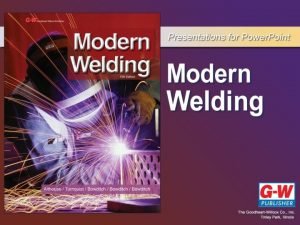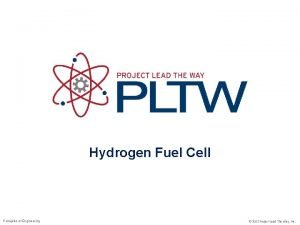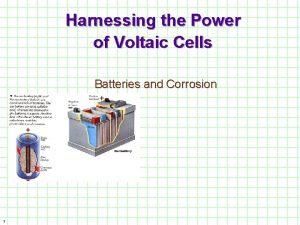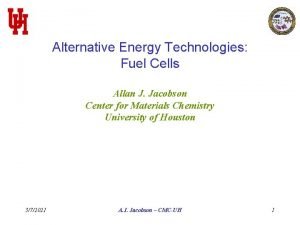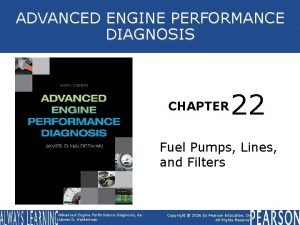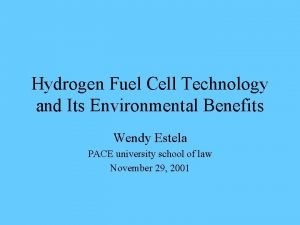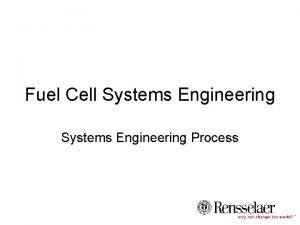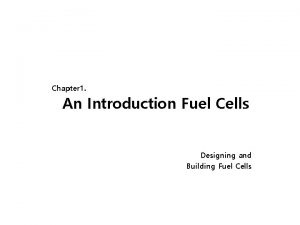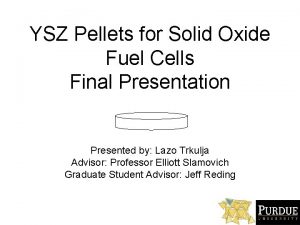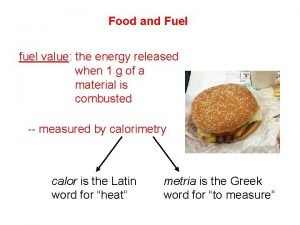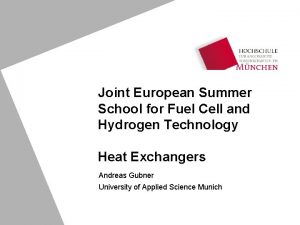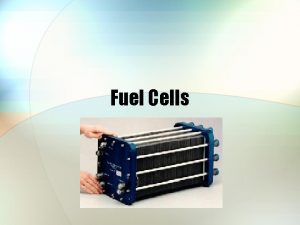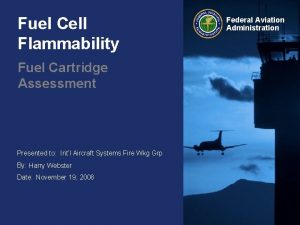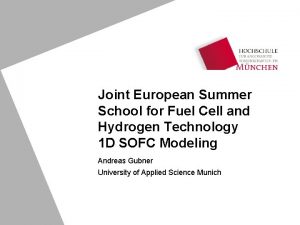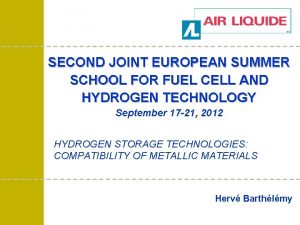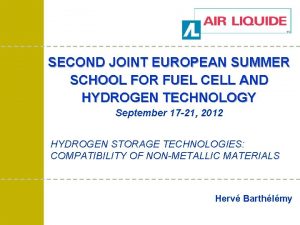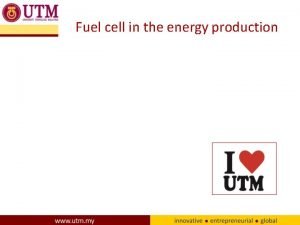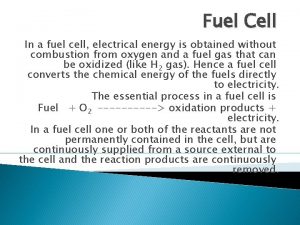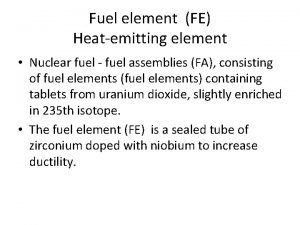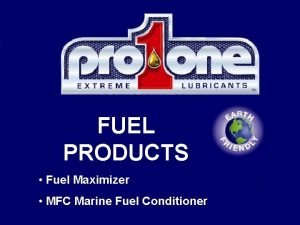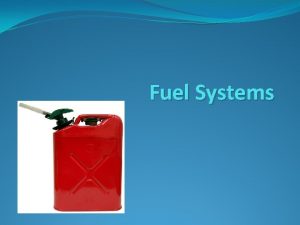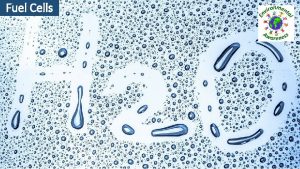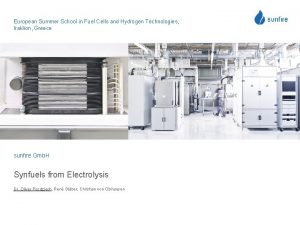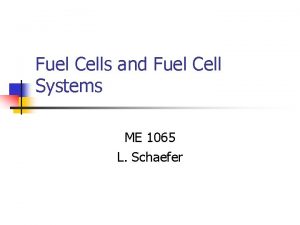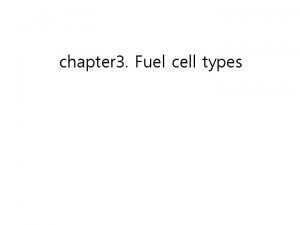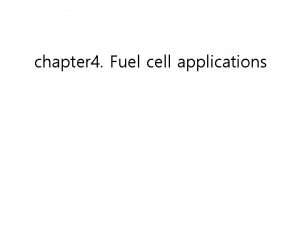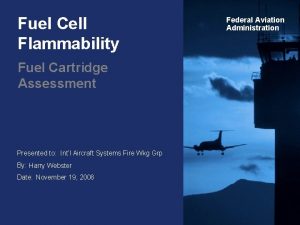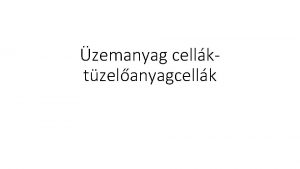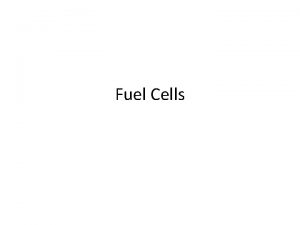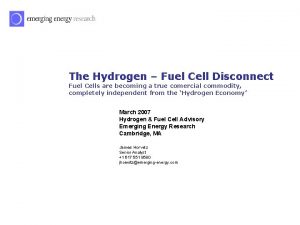Joint European Summer School for Fuel Cell and










































![Flow distribution analyzed using CFD Velocity distribution [m/s], cathode, ambient conditions (296 K, 1 Flow distribution analyzed using CFD Velocity distribution [m/s], cathode, ambient conditions (296 K, 1](https://slidetodoc.com/presentation_image_h/960a2dbaa687a3878eff9179af7f1079/image-43.jpg)
![Flow distribution analyzed using CFD Velocity distribution [m/s], cathode, ambient condition (296 K, 1 Flow distribution analyzed using CFD Velocity distribution [m/s], cathode, ambient condition (296 K, 1](https://slidetodoc.com/presentation_image_h/960a2dbaa687a3878eff9179af7f1079/image-44.jpg)


- Slides: 46

Joint European Summer School for Fuel Cell and Hydrogen Technology CFD based SOFC Modeling Andreas Gubner University of Applied Science Munich

Section CFD based 3 D Stack Modeling Including Internal Methane Reforming 3 D SOFC STACK MODELING 2 D 3 D SOFC Modeling Hier&wird der Titel der Präsentation wiederholt (Ansicht >Folienmaster) andreas. gubner@hm. edu 24. 11. 2020 2

Outline § Why conducting 3 D modeling of entire k. W-range stacks? § Introduction of a CFD-based 3 D model for k. W-range stacks § 1 D model justification § Conclusions & Outlook 2 D 3 D SOFC Modeling Hier&wird der Titel der Präsentation wiederholt (Ansicht >Folienmaster) andreas. gubner@hm. edu 24. 11. 2020 3

Current Situation § SOFC development of substrate-based planar cells reaches the phase of building and testing stacks in the k. W-range. § Several 10 -cell stacks achieving one to several k. W running on methane/steam (internal reforming) shown by various institutions § CFD based modeling has proven useful in SOFC development already but was limited to 5 - to 10 -cells in series due to excessive computation time needs. 2 D 3 D SOFC Modeling Hier&wird der Titel der Präsentation wiederholt (Ansicht >Folienmaster) andreas. gubner@hm. edu 24. 11. 2020 4

Objectives § Continue to increase the use of modeling as an engineering tool for k. W-range stack development. § Develop a CFD based model for 5 to 10 k. W stacks w/ 50 to 100 cells sized 20 by 20 cm 2 featuring comparatively low CPU time needs. § Integrate a suitable model into Bo. P analysis which requires to develop rapidly executing code. § Acquire the capability to model transient behavior as well. 2 D 3 D SOFC Modeling Hier&wird der Titel der Präsentation wiederholt (Ansicht >Folienmaster) andreas. gubner@hm. edu 24. 11. 2020 5

Modeling Strategy Comprised 3 D and 1 D Modeling Co Flo /Cou n Cro w On ter. Le ssflo ly, ast wa 2 D ! t 2 D 3 D SOFC Modeling Hier&wird der Titel der Präsentation wiederholt (Ansicht >Folienmaster) andreas. gubner@hm. edu 24. 11. 2020 6

From the Real SOFC-60 -Cell Stack to the CFD Model 2 D 3 D SOFC Modeling Hier&wird der Titel der Präsentation wiederholt (Ansicht >Folienmaster)

3 D Structural Model Verification: 10 Cell Stack Measurement w/ 5 -Cell Stack Simulation Operating Conditions: 35 l/min H 2 + 3% H 2 O, fuel utilization: u=39 % 100 l/min Air, f=1. 2, u=3. 1 furnace set @ 825°C current density: 275 m. A/cm² voltage: measured: 878 m. V per Cell calculated: 857 m. V per Cell 2 D 3 D SOFC Modeling Hier&wird der Titel der Präsentation wiederholt (Ansicht >Folienmaster) andreas. gubner@hm. edu 24. 11. 2020 8

3 D Structural CFD Model of a 60 Cell Stack: Temperature Distribution in the MEA Operating Conditions: 11. 3 l/min CH 4 + 1. 3 l/min H 2 + 22. 6 l/min H 2 O (S/C=2. 0), partially pre-reformed CH 4 258 l/min Air, f=2. 3, u=2. 9 furnace set @ 823 °C Tin, fuel = 355 °C Tin, air = 582 °C current density: 309 m. A/cm² avg. voltage: 767 m. V per Cell fuel utilization: 80 % 2 D 3 D SOFC Modeling Hier&wird der Titel der Präsentation wiederholt (Ansicht >Folienmaster) andreas. gubner@hm. edu 24. 11. 2020 9

3 D Structural CFD Model: Corresponding Local Current Density • Local current density follows the temperature distribution. • MEAs are most active where the highest temperatures are. • Even local current density distribution means fairly even flow distribution. 2 D 3 D SOFC Modeling Hier&wird der Titel der Präsentation wiederholt (Ansicht >Folienmaster) andreas. gubner@hm. edu 24. 11. 2020 10

Flow of Hydrogen Through the Stack • Temperature distribution & local current density correspond w/ highest H 2 - mole fractions. • Rapid reforming reaction (value of rate constant high). • Reforming is very temperature dependent which explains the S-shaped curvature. 2 D 3 D SOFC Modeling Hier&wird der Titel der Präsentation wiederholt (Ansicht >Folienmaster) andreas. gubner@hm. edu 24. 11. 2020 11

Velocity Distribution in the Anode (Fuel) Channels • Velocity increase caused by the reforming reactions and by the temperature increase. • Flow distribution is fairly even (is supported by the current density distribution as well). p=250 Pa 2 D 3 D SOFC Modeling Hier&wird der Titel der Präsentation wiederholt (Ansicht >Folienmaster) andreas. gubner@hm. edu p=0 Pa 24. 11. 2020 12

Temperature Difference between the (Isothermal) Furnace and the Stack Surface • Positive values represent heat transferred back to the furnace. • Negative values represent heat transferred to the stack by the furnace. positive values 0 • The stack surface exchanges heat with the inner furnace wall quite heavily. • Care must be taken in order to define the stack‘s thermal boundary conditions properly. • Technically interesting stacks should be in an insulating shell, not in a furnace. negative values 2 D 3 D SOFC Modeling Hier&wird der Titel der Präsentation wiederholt (Ansicht >Folienmaster) andreas. gubner@hm. edu 24. 11. 2020 13

Summary of a Case Study · Increasing pre-reforming degree moves T up & shifts maxima toward the fuel inlet. Less cooling by Reforming. · Increasing fuel utilization moves T up. Greater heat production. · Both should be balanced by increased air flow. 2 D 3 D SOFC Modeling Hier&wird der Titel der Präsentation wiederholt (Ansicht >Folienmaster) andreas. gubner@hm. edu 24. 11. 2020 14

Example of the 1 D Behavior Model Internal Reforming of CH 4 w/ S/C = 2, p = 1 bar(a), Tair, in = Tfuel, in = 550 °C, f = 80% Temperature Distribution: Interconnector- or Bipolar-Plate (Bi. P) and Gas Streams Species Mole Fraction Distribution: Reformation and Electrochemical Conversion 2 D 3 D SOFC Modeling Hier&wird der Titel der Präsentation wiederholt (Ansicht >Folienmaster) andreas. gubner@hm. edu 24. 11. 2020 15

Comparison of Experiment and Simulation Fuel Gas (partially pre-reformed CH 4) Molar Fractions in % Furnace Temperature: 690 °C H 2 6 CH 4 31 Counterflow H 2 O 63 Fuel Utilization: 40 % 100 Experiment CFD model 1 D model Stack Voltage in V 44. 8 44. 4 43. 4 Total Current in A 132 125 Electrical Power in W 5914 5861 5422 Maximum Temperature in °C 718 682 692 2 D 3 D SOFC Modeling Hier&wird der Titel der Präsentation wiederholt (Ansicht >Folienmaster) andreas. gubner@hm. edu 24. 11. 2020 16

Comparison of Experiment and Simulation 2 D 3 D SOFC Modeling Hier&wird der Titel der Präsentation wiederholt (Ansicht >Folienmaster) andreas. gubner@hm. edu 24. 11. 2020 17

(1) Comparison 1 D and 3 D Model: Temperature Profiles of the Interconnector Plates Cases A-C @ 50 % Fuel Utilization • • • Qualitative agreement but differences up to 40 K max. . 1 D Calculations yield a colder interconnector. Through drastic simplification from 3 D to 1 D, the 1 D Model can only exchange heat with the interconnector at its “tips“. More appropriate for “very large” stacks where the surrounding walls are far enough away so that their influence is negligible. 2 D 3 D SOFC Modeling Hier&wird der Titel der Präsentation wiederholt (Ansicht >Folienmaster) andreas. gubner@hm. edu 24. 11. 2020 18

(2) Comparison 1 D and 3 D Model: Temperature Profiles of the Interconnector Plates Cases D-F @ 80 % Fuel Utilization • Quantitatively better, differences reduce to 20 K max. . • More internal heat production through higher fuel utilization. 1 D Model currently either limited to a) fuel utilization > 50% or b) stacks much larger than 60 cells. Need to do this 1 D-3 D comparison for adiabatic stacks or stacks in a (thick) insulation, respectively. 2 D 3 D SOFC Modeling Hier&wird der Titel der Präsentation wiederholt (Ansicht >Folienmaster) andreas. gubner@hm. edu 24. 11. 2020 19

Summary § Managed to establish a modeling tool chain consisting of a 3 D CFD-based model and a rapidly executing 1 D model – Hierarchical Modeling § Models could be verified by experiments and by each other: 1 D results largely confirmed by 3 D results § Use 1 D model for systems modeling and 3 D model for aiding stack design 2 D 3 D SOFC Modeling Hier&wird der Titel der Präsentation wiederholt (Ansicht >Folienmaster) andreas. gubner@hm. edu 24. 11. 2020 20

Sensitivity Analysis of Typical Operation Parameters of a Solid Oxide Fuel Cell (SOFC) Stack SENSITIVITY ANALYSIS USING 3 D STACK MODELING 2 D 3 D SOFC Modeling Hier&wird der Titel der Präsentation wiederholt (Ansicht >Folienmaster) andreas. gubner@hm. edu 24. 11. 2020 21

Outline § Motivation for the presented work § Presentation of a typical SOFC Stack at test operation § Variation of operation parameters § Inaccuracies in material data § Influence of manufacturing tolerances 2 D 3 D SOFC Modeling Hier&wird der Titel der Präsentation wiederholt (Ansicht >Folienmaster) andreas. gubner@hm. edu 24. 11. 2020 22

Situation • 60 cells, active cell area 20 cm x 20 cm • Operation w/ H 2: • Operation w/ CH 4, H 2: 11, 9 k. W Stack height: approx. 40 cm 13, 3 k. W 2 D 3 D SOFC Modeling Hier&wird der Titel der Präsentation wiederholt (Ansicht >Folienmaster) andreas. gubner@hm. edu 24. 11. 2020 23

Variation of Operation Parameters § gas composition raising the amount of steam in hydrogen to 20 % § temperatures raising the Inlet temperature fuel/air, furnace temperature (all separately) by +50 K § air ratio raising the air ratio by 20 % § fuel utilization raising the fuel utilization by 50 % § load change raising the electrical load by 50 % 2 D 3 D SOFC Modeling Hier&wird der Titel der Präsentation wiederholt (Ansicht >Folienmaster) andreas. gubner@hm. edu 24. 11. 2020 24

Systematics of the Variations Dependancy of the Values Yk from the parameters Yi ¶Y k DYk = × DYi » Yk(2) - Yk(1) ¶Yi with Yk(1) from the basic simulation with Y 1, . . . , Yi, . . Yk(2) from the simulation with Y 1, . . . , Yi-1, Yi+D Yi, Yi+1, . . . The D Yi are chosen to cover a realistic variation range, based on a state with basic operating conditions (base case). 2 D 3 D SOFC Modeling Hier&wird der Titel der Präsentation wiederholt (Ansicht >Folienmaster) andreas. gubner@hm. edu 24. 11. 2020 25

Influence of the Operation Parameters change of Sim No. description Value (base case) U [m. V] TF, out [K] TA, out [K] Tmax [K] 1 H 2 O fraction 3% 17 % -26 3 -16 -2 2 TF, in 339 °C 50 K 2 0 6 6 3 TA, in 613 °C 50 K 11 17 8 16 4 Tfurnace 825 °C 50 K 45 54 105 178 50 Nl/min 10 Nl/min -13 -8 -22 5 6 fuel util. 20 % + 50 % -13 0 20 12 7 el. load 276 m. A/cm² + 50 % -12 18 76 144 2 D 3 D SOFC Modeling Hier&wird der Titel der Präsentation wiederholt (Ansicht >Folienmaster) andreas. gubner@hm. edu 24. 11. 2020 26

Influence of the Operation Parameters 2 D 3 D SOFC Modeling Hier&wird der Titel der Präsentation wiederholt (Ansicht >Folienmaster) andreas. gubner@hm. edu 24. 11. 2020 27

Influence of the Operation Parameters (2) change of Sim No. description value (base case) U [m. V] TF, out [K] TA, out [K] Tmax [K] 7 el. load 276 m. A/cm² + 50 % -12 18 76 144 8 el. load fuel 276 m. A/cm² H 2: 17. 5 Nl/min + 50 % 5 20 42 125 9 el. load fuel air 276 m. A/cm² H 2: 17. 5 Nl/min 50 Nl/min +50 % -67 -19 -10 -1 2 D 3 D SOFC Modeling Hier&wird der Titel der Präsentation wiederholt (Ansicht >Folienmaster) andreas. gubner@hm. edu 24. 11. 2020 28

Influence of the Material Data change of Sim No. description value (base case) U [m. V] TF, out [K] TA, out [K] Tmax [K] 1 heat conductivity of the steel 19 W/(m K) + 50 % -5 9 -2 -17 2 thickness of the electrolyte 17 mm + 50 % 7 1 1 2 3 thickness of the cathode 40 mm + 50 % 1 0 -1 1 4 H 2 polarisation (pre-exp. factor) 4. 75 e 8 + 50 % 19 -1 -2 -3 2 D 3 D SOFC Modeling Hier&wird der Titel der Präsentation wiederholt (Ansicht >Folienmaster) andreas. gubner@hm. edu 24. 11. 2020 29

Influence of the Material Data 2 D 3 D SOFC Modeling Hier&wird der Titel der Präsentation wiederholt (Ansicht >Folienmaster) andreas. gubner@hm. edu 24. 11. 2020 30

Fabrication Tolerances of the Gas Channels h = channel height b = channel width A = h*b = cross sectional area d = 2 hb/(h+b) = hyd. diameter 2 D 3 D SOFC Modeling Hier&wird der Titel der Präsentation wiederholt (Ansicht >Folienmaster) andreas. gubner@hm. edu 24. 11. 2020 31

Fabrication Tolerances of the Gas Channels Depending on the fabrication method, the cannels heights of a whole interconnector plane can vary by a tolerance E. A change of 10 % of all channel heights in a plane leads to a change of 18 % of the stream resistance. change of the channel height change of the stream resistance +5% - 10 % + 10 % - 19 % -5% +9% - 10 % + 19 % 2 D 3 D SOFC Modeling Hier&wird der Titel der Präsentation wiederholt (Ansicht >Folienmaster) andreas. gubner@hm. edu 24. 11. 2020 32

Fabrication Tolerances of the Gas Channels Influence of a raising by 20 % of the stream resistance in plane 3 2 D 3 D SOFC Modeling Hier&wird der Titel der Präsentation wiederholt (Ansicht >Folienmaster) andreas. gubner@hm. edu 24. 11. 2020 33

Conclusion § The dominating operation parameters are the electrical load and the furnace temperature. § The governing of the maximum temperature in the stack e. g. at load change is to be guaranteed by a suitable MSR design. § The influence of the furnace temperature takes no effect on insulated stacks in industrial applications. § The heat conduction affects the temperature maximum. § An enhancement of the polarization (cell development) improves the stack performance. § The influence of fabrication tolerances requires quality control measures. 2 D 3 D SOFC Modeling Hier&wird der Titel der Präsentation wiederholt (Ansicht >Folienmaster) andreas. gubner@hm. edu 24. 11. 2020 34

Section Modeling Aided Light Weight Cassette Design of an SOFC APU FLUID DYNAMICAL ANALYSIS OF SOFC APU DESIGN 2 D 3 D SOFC Modeling Hier&wird der Titel der Präsentation wiederholt (Ansicht >Folienmaster) andreas. gubner@hm. edu 24. 11. 2020 35

Outline § Introduction of APU requirements for transportation application § Fluid mechanical analysis § Derivation of design requirements and engineering guidelines using 3 D CFD modeling 2 D 3 D SOFC Modeling Hier&wird der Titel der Präsentation wiederholt (Ansicht >Folienmaster) andreas. gubner@hm. edu 24. 11. 2020 36

Stack Requirements for Automotive SOFC APU Targets Operation temperature 600 – 800°C Electrical Power 5 k. W Fuel Diesel and gasoline, via POX Durability > 5000 hrs Thermocycles > 5000 Fuel utilization > 60 % Start up time < 2 minutes Specific weight < 4 kg/k. W Specific volume ~ 1 l/k. W Specific system costs < 500 €/k. W Pressure drop (anode and cathode side) < 100 mbar 2 D 3 D SOFC Modeling Hier&wird der Titel der Präsentation wiederholt (Ansicht >Folienmaster) andreas. gubner@hm. edu 24. 11. 2020 37

Engineering Diagram Development for fluidmechanical Gas Channel Design j dh Aquer 2 D 3 D SOFC Modeling Hier&wird der Titel der Präsentation wiederholt (Ansicht >Folienmaster) andreas. gubner@hm. edu 24. 11. 2020 38

Modeling and design 1 D analytical approach based on laminar Hagen-Poiseuille flow for rapid estimation of pressure drops Calculation based on CFD simulation Velocity distribution 2 D 3 D SOFC Modeling Hier&wird der Titel der Präsentation wiederholt (Ansicht >Folienmaster) andreas. gubner@hm. edu 24. 11. 2020 39

Analytical approach for estimating the form factor Hagen-Poiseuille flow Geometrical assumptions Physical assumptions 2 D 3 D SOFC Modeling Hier&wird der Titel der Präsentation wiederholt (Ansicht >Folienmaster) andreas. gubner@hm. edu 24. 11. 2020 40

Analytical approach for estimating the form factor Verification of the CFD-based calculations for the form factor Literature CFD (FLUENT) Rectangle (height / width = 0. 25) 1. 14 1. 12 Square (height / width = 1) 0. 89 0. 88 Equilateral triangle (side = 2) 0. 83 Velocity distribution 2 D 3 D SOFC Modeling Hier&wird der Titel der Präsentation wiederholt (Ansicht >Folienmaster) andreas. gubner@hm. edu 24. 11. 2020 41

Engineering Diagrams for Rapid Pressure Drop Estimation - - Diagram (Validity: 0. 5) - dh - Diagram (Validity: 0) - A - Diagram (Validity: 0) 2 D 3 D SOFC Modeling Hier&wird der Titel der Präsentation wiederholt (Ansicht >Folienmaster) andreas. gubner@hm. edu 24. 11. 2020 42
![Flow distribution analyzed using CFD Velocity distribution ms cathode ambient conditions 296 K 1 Flow distribution analyzed using CFD Velocity distribution [m/s], cathode, ambient conditions (296 K, 1](https://slidetodoc.com/presentation_image_h/960a2dbaa687a3878eff9179af7f1079/image-43.jpg)
Flow distribution analyzed using CFD Velocity distribution [m/s], cathode, ambient conditions (296 K, 1 atm) Experiment Flow rate [l/min] 2. 5 E-01 2. 0 E-01 1. 5 E-01 1. 0 E-01 5. 0 E-02 0. 0 E+00 0 20 CFD simulation 40 60 80 100 120 140 Plate width [mm] Reynolds number kept unchanged ensuring similarity between real and experimental condition. Maximum deviation between experiments and CFD simulations about 14 %, mean deviation about 10 %. 2 D 3 D SOFC Modeling Hier&wird der Titel der Präsentation wiederholt (Ansicht >Folienmaster) andreas. gubner@hm. edu 24. 11. 2020 43
![Flow distribution analyzed using CFD Velocity distribution ms cathode ambient condition 296 K 1 Flow distribution analyzed using CFD Velocity distribution [m/s], cathode, ambient condition (296 K, 1](https://slidetodoc.com/presentation_image_h/960a2dbaa687a3878eff9179af7f1079/image-44.jpg)
Flow distribution analyzed using CFD Velocity distribution [m/s], cathode, ambient condition (296 K, 1 atm) closed Bypass 2 D 3 D SOFC Modeling Hier&wird der Titel der Präsentation wiederholt (Ansicht >Folienmaster) andreas. gubner@hm. edu 24. 11. 2020 44

Results of Fluidmechanical Analysis of CP- and CS Design § Bypass in Cathode Flowfield causes 13 % flow rate loss and an uneven flow distribution. § After Eliminating the Bypass, the flow distribution can be evened out to max. 9 % of its average value. § The Pressure Loss Ratio of two investigated Designs (CP- und CS-Design) was approx. § CS-Design is superior from a fluid mechanical point of view. However, ist channel width should be reduced due to contact resistance requirements. 2 D 3 D SOFC Modeling Hier&wird der Titel der Präsentation wiederholt (Ansicht >Folienmaster) andreas. gubner@hm. edu 24. 11. 2020 45

Acknowledgement The Work presented in this talk was carried out at the Forschungszentrum Jülich from 2002 to 2006 This work was a team effort. I would like to thank all the people of our former team and especially Dieter Froning without whose amazing programming skills the 3 D CFD model would have never materialized. 2 D 3 D SOFC Modeling Hier&wird der Titel der Präsentation wiederholt (Ansicht >Folienmaster) andreas. gubner@hm. edu 24. 11. 2020 46
 Torches
Torches What is fuel cell in chemistry
What is fuel cell in chemistry Fuel cell apollo
Fuel cell apollo Fuel cell apollo
Fuel cell apollo Roller cell fuel pump
Roller cell fuel pump Hydrogen cycle
Hydrogen cycle Fuel cell uses
Fuel cell uses Fuel cell system
Fuel cell system Molten carbonate fuel cell
Molten carbonate fuel cell Solid oxide fuel cell
Solid oxide fuel cell Valuetheenergy.com
Valuetheenergy.com Fuel cell heat exchanger
Fuel cell heat exchanger Alkaline fuel cell animation
Alkaline fuel cell animation Fuel cell cartridge
Fuel cell cartridge Summer school lodi unified
Summer school lodi unified Crescenta valley high school summer school
Crescenta valley high school summer school Assignment in spanish
Assignment in spanish Which joint is permanent types
Which joint is permanent types Condyloid ellipsoidal joint
Condyloid ellipsoidal joint Lamb quality grades
Lamb quality grades What type of joint is the intervertebral joint
What type of joint is the intervertebral joint Memorandum joint venture
Memorandum joint venture Lamb grading chart
Lamb grading chart Difference between mercury cell and diaphragm cell
Difference between mercury cell and diaphragm cell Prokaryotic reproduction
Prokaryotic reproduction Venn diagram plant and animal cell
Venn diagram plant and animal cell Plant cell and animal cell diagram
Plant cell and animal cell diagram Plant cell structure and function
Plant cell structure and function Lead acid battery primary or secondary
Lead acid battery primary or secondary Difference between plant and animal cell
Difference between plant and animal cell Events of the cell cycle
Events of the cell cycle Life
Life The scientist mathias schleiden studied _______ in ______.
The scientist mathias schleiden studied _______ in ______. Idealized animal cell
Idealized animal cell Walker cell and hadley cell
Walker cell and hadley cell Cell cycle and cell division
Cell cycle and cell division Plant cell animal cell venn diagram
Plant cell animal cell venn diagram Phases of cell cycle
Phases of cell cycle Applications of electrolytic cell
Applications of electrolytic cell Flexible covering of an animal cell
Flexible covering of an animal cell Fspos
Fspos Typiska novell drag
Typiska novell drag Tack för att ni lyssnade bild
Tack för att ni lyssnade bild Vad står k.r.å.k.a.n för
Vad står k.r.å.k.a.n för Varför kallas perioden 1918-1939 för mellankrigstiden
Varför kallas perioden 1918-1939 för mellankrigstiden En lathund för arbete med kontinuitetshantering
En lathund för arbete med kontinuitetshantering Särskild löneskatt för pensionskostnader
Särskild löneskatt för pensionskostnader
